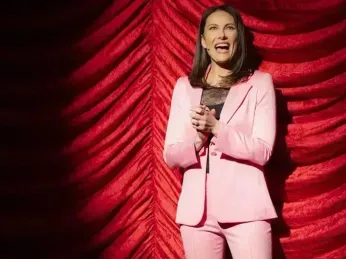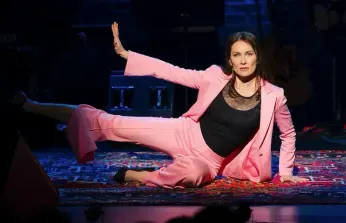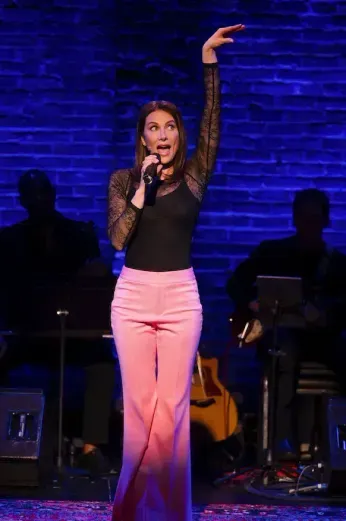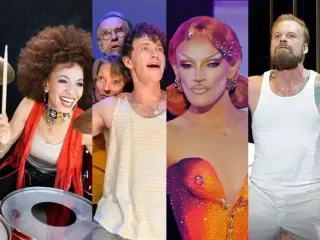
Sep 11
Laura Benanti – Stage and screen star brings her ‘Nobody Cares’ solo show to Berkeley Rep
Jim Provenzano READ TIME: 1 MIN.
She’s starred in multiple Broadway hits and won a Tony for one role (“Gypsy”). She’s an accomplished mother and a TV and film actor as well. Yet according to Laura Benanti, “Nobody Cares.” That’s the multiply-layered title of her witty solo show with new songs, where instead of princesses and strippers, Benanti’s show focuses on motherhood, life worries. It runs at Berkeley Repertory September 17-25, after successful dates at the Edinburgh Fringe Festival, and at the Minetta Lane Theatre in Manhattan.
In an interview with The Bay Area Reporter, Benanti discussed the inspiration and creation of her new show, and why she calls herself a “recovering ingenue.”

“The show is about my journey from being an 18-old girl playing a grown woman on Broadway opposite a 70-year-old man, and all of the trappings that came with that,” said Benanti from her New Jersey home.
“While I’m so grateful to have had that experience, there are pitfalls to playing characters from 1950s musicals, and how I sort of brought that into my personal life. It’s a journey from that to the person I am now, which is a grown woman and the mother of two girls. A lot of it is about my predisposition toward people-pleasing, and you just can’t be that when you have children, because they will never like you all the time.”
Benanti’s path to show business was almost inevitable.
“I grew up in New Jersey and my parents [themselves in the performing arts] would not allow me to be a professional child actor, which I’m now grateful for,” she said. “But at the time, I was serious and they allowed me to do my high school show and a community theater play. When I was 15, I played Cinderella and “Into the Woods” at the Barn Theater, and then when I was 21, I played her on Broadway.”
“The older and older I get, the more I know, that there are so many talented people in this world. I just came back from the Edinburgh Fringe Festival and there were 4,000 shows there. So many talented people get only so many opportunities.”
This is where a show expands its themes of self-doubt and buried emotions. “Not even just performers,” Benanti said, “but we all feel at some point in our lives; is anybody noticing how hard I’m working? Is anybody noticing the care and time that I’m putting into whatever it is, my work into this friendship and to being a mother and to all of it, and it’s two-pronged for me.”
Sound effects
Benanti explained how her new show was inspired by a commission from Audible to create a story for audio.
“As I started writing it, I thought, ‘Nobody cares.’ This was during the pandemic. ‘Who cares what a middle-aged white lady has to say at this moment?’ But they had paid me, so I had to keep writing. Two years after they paid me, they wrote, ‘Hey, could you write that show please?’ And so I finally did. It was a gratifying experience to see how many people actually did care, but it’s a double meaning in that what I have learned over the course of my life as a person with has brought a lot of external validation. It’s part and parcel of my job, but I think that can seep into your everyday life.”
The show’s title soon flips to letting go of worries about whether others care.
“All of the things I used to worry about,” Benanti continued, “the things I said in 1997, ‘Are my clothes cool?’ Whatever stupid thing that I was obsessed with; whatever negative thing people were thinking of me; nobody cares. Nobody is paying that much attention to anybody else, and frankly, if they do, that’s none of my business. What other people think of me is actually none of my business. It leaves me to work on myself. ‘You know what? I don’t care.’”
Fan base, out of place
Benanti talked about audience the surprising reactions to her new show.
“I have so many different kinds of people coming up to me saying how much they related to it,” she said. “Young women, a lot of Gen Z women, millennial women, women my age, their moms, and then of course my beloved gays, my favorite kind of men [Benanti has performed with Boston, Washington, D.C. and San Francisco Gay Men’s Choruses]. My personal favorites are husbands and boyfriends who were dragged there against their will, who now say things like, ‘That was one of my favorite shows I’ve seen.’
“That makes me feel really good, because while I certainly didn’t write this show for everyone, the fact that most of the audience walks away feeling seen and a little bit better about themselves is really gratifying, and mostly, it’s just funny. You do not need to like Broadway at all or know anything about Broadway in order to enjoy this show.”
Defining her show’s style may not be easy, and Benanti does include a warning.
“It’s most akin to stand-up comedy and with original comedy songs, and that’s very important to me that people understand that what they are coming to see is a one-hour comedy show with original comedy music written with Todd Almond. I will not be singing any Broadway songs at all. It’s adult content. Really, it should be 16+.
“It’s really important,” Benanti said about clarifying the adult content in her show. Recalling a Fringe night where a parent brought a 6-year-old child, she said, “It was really hard for me. I’d say some things that are not appropriate for children, and I straight up was like, ‘Hey, can he not be here?’ And they were like, ‘Nope.’

“I tried to let it go, but I just felt really bad that this child is hearing things that are not age-appropriate, and there definitely were a few people who, during the course of the show, I could tell they came there thinking I was going to sing, ‘I Could Have Danced All Night,’ and instead, I’m singing a song where I say, ‘We don’t want to see your dicks unless we say we do.’
“It’s not what you might expect of me, and I think that’s the joy for most people, but I also really want people to understand what they’re in for. There was a 96-year-old woman who came in London who said, ‘I love this show so much. I thought you were going to sing ‘The Sound of Music,’ and I’m so glad you did this instead."
It’s the onstage/offstage aspects of her life that inform her story.
“My theater life and my personal life are completely intertwined because it was my life for so long,” said Benanti when asked if ‘backstage stories’ will be included. “I have been so blessed, starred in Broadway shows starting at 18 years old, and then I’ve gone on to do a lot of TV, and some movies and comedy. But I spent the first 12 years of my adult life within a six-block radius of Broadway, and my world was very small. The roles I was playing had become internalized.”
Benanti said how her life and roles affected each other, including “some of the less desirable behavior that I think that brought out in me,” she said. “It’s not about theater, it’s about me, but you can’t sort of separate one from the other.”
Off-road, on-air
After some off-the-record chatting about Benanti’s guest-star roles in acclaimed series like “Nashville,” “Elsbeth,” “The Gilded Age,” it came time to bring up Benanti’s television breakthrough; her impressions on Melania Trump, shown on “The Late Show with Steven Colbert” since 2016.
“It’s been huge for my life in multiple ways,” said Benanti, who credited the show’s writers. “It thrust me into the world of people threatening my life for comedy, which is always fun. But it’s the thing that really finally put me on the map as a comic actor. I think for a long time, I just had to prove over and over again that I was funny. It was definitely the thing that people started to take me seriously for being funny.”
And while the First Lady hasn’t commented, Benanti said, “I’m actually really shocked that [Trump] hasn’t come after me. He came after Alec Baldwin really hard for satirizing him, but then I realized he doesn’t give a shit because it’s not him. Although of course, we’re just using her as a vessel to make fun of him.”
Benanti, who was in San Francisco in 2016 for cabaret concerts, also performed in Andrew Lippa’s oratorio, “I Am Harvey Milk” in 2013. She said she’s looking forward to visiting the Bay Area again.
“I’ve been there multiple times by myself and also with my mom,” she said. “And the San Francisco Gay Men’s Chorus is very near and dear to my heart. I have a video of them all singing Happy Birthday to my daughter. We watch it every year. So yeah, I mean I love the Bay Area, but I’ve never really spent time in Berkeley. Annie Tippe, who’s my director, has done four shows there. She says it’s her favorite place she’s ever worked.”
‘Laura Benanti: Nobody Cares,’ $49-$89, Sept. 17-25, Berkeley Repertory, 2025 Addison St. www.berkeleyrep.org/

